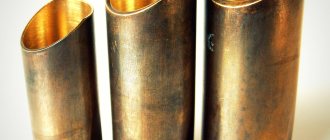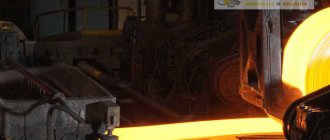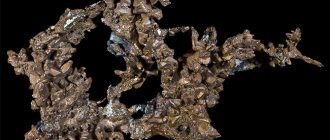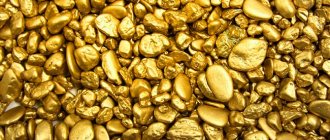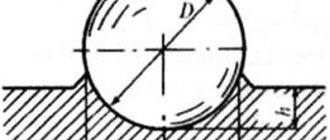Marking of copper and alloys based on it
When it comes to technical copper, the marking contains the letter M. Next are numbers indicating the degree of its purity. For example, M3 copper includes more impurities compared to M000 material. The letters at the end mean the following:
- B-oxygen-free material;
- R - deoxidized;
- K-cathode.
Copper in its pure form is often used as a conductor material for electrical purposes. The material lends itself well to soldering, deformation and welding, the only drawback is that it is difficult to cut.
In copper alloys, markings have an alphanumeric system by which their chemical composition can be determined. Thus, alloying elements are indicated by their initial letters, for example:
- K-silicon;
- Phosphorus;
- B-beryllium;
- O-tin, etc.
Brass
Brass is an alloy of copper and zinc . They are divided into the following types:
- two-component (simple) - include mainly copper and zinc, as well as impurities in small quantities;
- multicomponent (special) - in addition to the main elements, there are additional alloying ones.
The markings for plain brass include the letter "L" indicating the type of alloy, as well as a two-digit number indicating the average amount of copper in the composition.
Two-component alloys respond well to pressure and can take forms such as:
- tubes and pipes with different sections;
- stripes;
- sheets;
- rods with different profiles;
- wire.
If products have high internal stress, they are prone to cracking. And if they are stored outdoors for a long time, transverse and longitudinal cracks may appear. To prevent this from happening, relieve internal stress by annealing at temperatures up to 300 degrees.
The marking of multi-component brass after the letter “L” contains letters indicating the alloying elements in the composition (in addition to zinc). Next comes a series of numbers separated by a hyphen, the first number is the average amount of copper (in %), and then - each alloying element in the order corresponding to the letter designation. The order of letters and numbers depends on which element is contained.
Those that are larger come first, then the elements are indicated in descending order. Cast brass is marked with letters LC (the second letter is zinc), followed by a number indicating the percentage of zinc content. Further marking proceeds, as in other cases. These types of materials are used in the production of bushings, shipbuilding materials, bearings, fittings and liners.
Bronze
Bronze refers to a combination of copper with other elements, without zinc being the main component. Bronze can be deformed or cast. The marking of such material begins with the letter combination “Br”.
In casting types, these letters are followed by letters with numbers indicating the elements and their percentage in the alloy. The rest is assumed to be copper. In some cases, the marking has the letter “L” at the end, indicating that the material is foundry.
Bronze has excellent casting properties and is used for shaped casting. It is also used as an anti-friction and corrosion-resistant material in the production of:
- worm wheels;
- headbands;
- bushings;
- gears;
- fittings;
- valve seats, etc.
In addition to the listed features, it is worth noting that all copper alloys are highly resistant to low temperatures.
- 1. Non-ferrous metals and alloys, their properties and purpose
- 2. Copper alloys
- 3. Aluminum alloys
- 4. Titanium alloys
- 5. Zinc alloys
LECTURE No. 11. Alloys of non-ferrous metals
1. Non-ferrous metals and alloys, their properties and purpose
The valuable properties of non-ferrous metals have led to their widespread use in various branches of modern production. Copper, aluminum, zinc, magnesium, titanium and other metals and their alloys are irreplaceable materials for the instrument-making and electrical industries, aircraft manufacturing and radio electronics, nuclear and space technology. Non-ferrous metals
have a number of valuable properties: high thermal conductivity, very low density (aluminum and magnesium), very low melting point (tin, lead), high corrosion resistance (titanium, aluminum). Aluminum alloys with other alloying elements are widely used in various industries.
Magnesium-based alloys are characterized by low density, high specific strength, and are easy to cut. They have found wide application in mechanical engineering and in particular in aircraft manufacturing.
Technical copper, containing no more than 0.1% impurities, is used for various types of current conductors.
Copper alloys
According to their chemical composition, they are classified into brass and bronze.
In turn, brasses
, according to their chemical composition, are divided into simple ones, alloyed only with zinc, and special ones, which, in addition to zinc, contain lead, tin, nickel, and manganese as alloying elements.
Bronze
also divided into tin and tin-free.
Tin-free bronzes
have high strength, good anti-corrosion and anti-friction properties.
Magnesium is widely used in metallurgy, with the help of which deoxidation and desulfurization of certain materials are carried out.
a variety of metals and alloys, modify gray cast iron to obtain spherical graphite, produce difficult-to-reduce metals (for example, titanium), mixtures of magnesium powder with oxidizing agents are used for the manufacture of lighting and incendiary rockets in rocket technology and pyrotechnics. The properties of magnesium are significantly improved by alloying. Aluminum and zinc with a mass fraction of up to 7% increase its mechanical properties, manganese improves its corrosion resistance and weldability, zirconium, introduced into the alloy along with zinc, refines the grain (in the structure of the alloy), increases mechanical properties and corrosion resistance.
Magnesium alloys are used to make shaped castings, as well as semi-finished products - sheets, plates, rods, profiles, pipes, wires. Industrial magnesium is obtained by electrolytic method from magnesite, dolomite, carnallite, sea water and waste from various industries according to the scheme of obtaining pure anhydrous magnesium salts, electrolysis of these salts in the molten state and refining of magnesium. In nature, powerful accumulations form magnesium carbonates - magnesite and dolomite, as well as carnallites .
In the food industry, packaging foil made of aluminum and its alloys is widely used - for wrapping confectionery and dairy products, and aluminum cookware is also used in large quantities (cookers, trays, bathtubs, etc.).
2. Copper alloys
Copper is one of the metals known since ancient times. Man's early acquaintance with copper was facilitated by the fact that it occurs in nature in a free state in the form of nuggets, which sometimes reach significant sizes. Currently, copper is widely used in electrical engineering, in the construction of power lines, for the manufacture of telegraph and telephone communication equipment, radio and television equipment. Wires, cables, busbars and other conductive products are made from copper. Copper has high electrical and thermal conductivity, strength, toughness and corrosion resistance. Its physical properties are determined by its structure. It has a cubic gra-non-centered spatial lattice. Its melting point is +1083 °C, boiling point is +2360 °C. The average tensile strength depends on the type of treatment and ranges from 220 to 420 MPa (22–45 kgf/mm2), relative elongation – 4–60%, hardness – 35–130 HB, density – 8.94 g/cm3. Having remarkable properties, copper at the same time as a structural material does not satisfy the requirements of mechanical engineering, so it is alloyed, i.e., metals such as zinc, tin, aluminum, nickel and others are added to alloys, thereby improving its mechanical and technological properties . In its pure form, copper is used to a limited extent; its alloys are used more widely. According to their chemical composition, copper alloys are divided into brass, bronze and copper-nickel, and according to their technological purpose - into wrought, used for the production of semi-finished products (wire, sheet, strip, profile), and foundry, used for casting parts.
Brass
– alloys of copper with zinc and other components. Brasses containing, in addition to zinc, other alloying elements are called complex, or special, and are named according to the alloying components introduced, in addition to zinc. For example: tompak L90 is brass containing 90% copper, the rest is zinc; aluminum brass LA77–2 - 77% copper, 2% aluminum, the rest is zinc, etc. Compared to copper, brasses have great strength, corrosion resistance and elasticity. They are processed by casting, pressing and cutting. Semi-finished products are made from them (sheets, tapes, strips, pipes of condensers and heat exchangers, wire, stampings, shut-off valves - taps, valves, medals and badges, artistic products, musical instruments, bellows, bearings).
Bronzes are copper-based alloys in which tin, aluminum, beryllium, silicon, lead, chromium and other elements are used as additives. Bronzes are divided into tin-free (BrA9Mts2L, etc.), tin (BrO3ts12S5, etc.), aluminum (BrA5, BrA7, etc.), silicon (BrKN1–3, BrKMts3–1), manganese (BrMts5), beryllium bronzes (BrB2, BrBNT1,7, etc.). Bronze is used for the production of shut-off valves (taps, valves), various parts operating in water, oil, steam, mildly aggressive environments, and sea water.
3. Aluminum alloys
The name "aluminum" comes from the Latin word alumen - so 500 years BC. e. called aluminum alum, which was used for etching when dyeing fabrics and tanning leather.
In terms of abundance in nature, aluminum ranks third after oxygen and silicon and first among metals. In terms of use in technology, it ranks second after iron. Aluminum is not found in free form; it is obtained from minerals - bauxite, nepheline and alunite, while alumina is first produced, and then aluminum is obtained from alumina by electrolysis. The mechanical properties of aluminum are low: tensile strength – 50–90 MPa (5–9 kgf/mm2), relative elongation – 25–45%, hardness – 13–28 HB.
Aluminum welds well, but is difficult to machine, has a large linear shrinkage - 1.8% In its pure form, aluminum is rarely used; its alloys with copper, magnesium, silicon, iron, etc. are widely used. Aluminum and its alloys are necessary for aviation and mechanical engineering, power lines, metro and railway rolling stock.
Aluminum alloys are divided into cast and wrought. Cast aluminum alloys are produced in ingots - refined and unrefined.
Alloys with the letter “P” in their brand designations are intended for the manufacture of food utensils. The mechanical properties of alloys depend on their chemical composition and production methods. The chemical composition of the main components included in the alloy can be determined by grade. For example, AK12 alloy contains 12% silicon, the rest is aluminum; AK7M2P – 7% silicon, 2% copper, the rest is aluminum. The most widely used aluminum-silicon alloy in various industries is silumin, which is produced in four grades: SIL-00,
STR-0, STR-1 and STR-2. In addition to aluminum (base) and silicon (10–13%), this alloy includes: iron – 0.2–0.7%, manganese – 0.05–0.5%, calcium – 0.7–0.2 %, titanium - 0.05-0.2%, copper - 0.03% and zinc - 0.08%. Various parts for cars, tractors, and passenger cars are made from silumins. Aluminum wrought alloys in ingots, intended for pressure processing and for shearing in the production of other aluminum alloys, are standardized by certain standards. Alloys for forming consist of aluminum (base), alloying elements (copper - 5%, magnesium - 0.1-2.8%, manganese - 0.1-0.7%, silicon - 0.8-2.2 %, zinc - 2–6.5% and a small amount of other impurities). The grades of these alloys are: VD1, AVD1, AVD1–1, AKM; semi-finished products are made from aluminum alloys - sheets, strips, strips, slabs, ingots, slabs.
In addition, non-ferrous metallurgy produces aluminum anti-friction alloys used for the manufacture of monometallic and bimetallic bearings by casting. Depending on the chemical composition, the standard provides for the following grades of these alloys: AO3–7, AO9–2, AO6–1, AO9–1, AO20–1, AMST. The standard also defines the operating conditions for products made from these alloys: load from 19.5 to 39.2 MN/m2 (200–400 kgf/cm2), temperature from 100 to 120 °C, hardness from 200 to 320 HB.
4. Titanium alloys
Titanium
– silver-white metal. It is one of the most common elements in nature. Among other elements in terms of abundance in the earth’s crust (0.61%), it ranks tenth. Titanium is light (its density is 4.5 g/cm3), refractory (melting point 1665 °C), very durable and ductile. A persistent oxide film forms on its surface, due to which it resists corrosion well in fresh and sea water, as well as in some acids. At temperatures up to 882 °C it has a hexagonal densely packed lattice, at higher temperatures it has a body-centered cube. The mechanical properties of titanium sheets depend on the chemical composition and method of heat treatment. Its tensile strength is 300–1200 MPa (30–120 KGS/mm2), relative elongation is 4–10%. The harmful impurities of titanium are nitrogen, carbon, oxygen and hydrogen. They reduce its ductility and weldability, increase hardness and strength, and worsen corrosion resistance.
At temperatures above 500 °C, titanium and its alloys easily oxidize, absorbing hydrogen, which causes embrittlement (hydrogen embrittlement). When heated above 800 °C, titanium energetically absorbs oxygen, nitrogen and hydrogen; this ability is used in metallurgy to deoxidize steel. It serves as an alloying element for other non-ferrous metals and for steel.
Due to their remarkable properties, titanium and its alloys are widely used in aircraft, rocket and shipbuilding. Semi-finished products are made from titanium and its alloys: sheets, pipes, rods and wire. The main industrial materials for titanium production are ilmenite, rutile, perovskite and sphene (titanite). The technology for producing titanium is complex, labor-intensive and time-consuming: first, titanium sponge is produced, and then malleable titanium is produced from it by melting in vacuum furnaces.
sponge titanium,
obtained by the magnesium-thermal method, serves as the starting material for the production of titanium alloys and other purposes. Depending on the chemical composition and mechanical properties, the following grades of titanium sponge are established as standard: TG-90, TG-100, TG-110, TG-120, TG-130. In the designation of brands, the letters “TG” mean spongy titanium, “Tv” means hard, and the numbers mean Brinell hardness. Titanium sponge contains impurities: iron - up to 0.2%, silicon - up to 0.04%, nickel - up to 0.05%, carbon - up to 0.05%, chlorine - up to 0.12%, nitrogen - up to 0 .04%, oxygen – up to 0.1%. Titanium and titanium alloys processed by pressure are intended for the manufacture of various semi-finished products (sheets, pipes, rods, wire). Depending on the chemical composition, the standard provides for the following grades: VT1-00, VT1-0, OT4-0, OT4-1, OT4, VT5, VT5-1, VT6, VT20, VT22, PT-7M, PT-7V, PT –1 m. Main components: aluminum – 0.2–0.7%, manganese – 0.2–2%, molybdenum – 0.5–5.5%, vanadium – 0.8–5.5%, zirconium – 0.8–3%, chromium – 0.5–2.3%, tin – 2–3%, silicon – 0.15–0.40%, iron – 0.2–1.5%. Iron, silicon and zirconium, depending on the brand of the alloy, can be the main components or impurities.
5. Zinc alloys
Zinc copper alloy - brass
– was known to the ancient Greeks and Egyptians. But zinc smelting on an industrial scale began only in the 17th century.
Zinc
– the metal is light gray-bluish in color, brittle at room temperature and at 200 °C, when heated to 100–150 °C it becomes ductile.
In accordance with the standard, zinc is produced and supplied in the form of pigs and blocks weighing up to 25 kg. The standard also establishes grades of zinc and their areas of application: TsV00 (zinc content - 99.997%) - for scientific purposes, the production of chemical reagents, the manufacture of products for the electrical industry; CVO (zinc – 99.995%) – for the printing and automotive industries; TsV1, TsV (zinc – 99.99%) – for the production of injection moldings intended for the manufacture of critical parts, for the production of zinc oxide, zinc powder and pure reagents; TsOA (zinc 99.98%), TsO (zinc 99.975%) - for the production of zinc sheets, pressure-processed zinc alloys, whitewash, alloys, for hot-dip and galvanizing; Ts1S, Ts1, Ts2S, Ts2, Ts3S, Ts3 - for various purposes.
Zinc alloys are widely used in industry: brass, zinc bronze, alloys for coating various steel products, manufacturing galvanic elements, printing, etc. Zinc alloys in ingots for casting are standardized by the standard. These alloys are used in automobile and instrument making, as well as in other industries. The standard establishes the grades of alloys, their chemical composition, and defines the products made from them:
1) TsAM4–10 – especially critical parts;
2) TsAM4–1 – critical parts;
3) TsAM4–1V – non-critical parts;
4) TsA4O – critical parts with stable dimensions;
5) TsA4 – non-critical parts with stable dimensions.
Zinc antifriction alloys,
intended for the production of monometallic and bimetallic products, as well as semi-finished products, using casting and pressure processing methods are standardized by the standard.
The mechanical properties of alloys depend on their chemical composition: tensile strength ?B
= 250–350 MPa (25–35 KGS/mm2), relative elongation
?
= 0.4–10%, hardness – 85–100 HB. The standard establishes the grades of these alloys, their areas of application and operating conditions: TsAM9–1.5L – casting of monometallic liners, bushings and sliders; permissible: load – 10 MPa (100 kgf/cm2), sliding speed – 8 m/s, temperature 80 °C; if bimetallic parts are produced by casting in the presence of a metal frame, then the load, sliding speed and temperature can be increased to 20 MPa (200 KGS/cm2), 10 m/s and 100 °C, respectively: TsAM9–1.5 - obtaining bimetallic tapes (zinc alloy with steel and duralumin) by rolling method, the tape is intended for the manufacture of liners by stamping; permissible: load – up to 25 MPa (250 kgf/cm2), sliding speed – up to 15 m/s, temperature 100 °C; AM10–5L – casting of bearings and bushings, permissible: load – 10 MPa (100 KGS/cm2), sliding speed – 8 m/s, temperature 80 °C.
Table of contents
Characteristics of aluminum and aluminum alloys
Aluminum can be produced as wire rod, ingots, pigs and much more, as well as as a deformable semi-finished product (profiles, rods, sheets and much more). Depending on the degree of presence of impurities, the material can have three types of purity:
- special;
- high;
- technical.
Primary aluminum is marked with the letter “A”, as well as a number indicating the amount of impurities in it.
This material lends itself well to deformation, but is difficult to cut. By rolling it can be used to produce foil.
Aluminum alloys are wrought and cast.
The marking of cast aluminum surrogates includes their main composition. Mostly it starts with the letter “A”, which indicates aluminum as the main material. Then there are letters and numbers, depending on the other elements and their percentage in the alloy. Some begin with the letters "AL", which means cast aluminum alloy, followed by a number corresponding to the material number. If the letter “B” appears at the beginning, this indicates high strength.
Aluminum and its alloys have a wide range of uses. Thus, technical aluminum can be used in electrical engineering as a current conductor instead of copper. And casting alloys are often used in the food and refrigeration industries in the production of parts of complex shapes that are resistant to corrosion and have low density. For example, these are levers, compressor pistons and much more.
And deformable aluminum surrogates in the same area are used in the production of parts through pressure processing. These are rivets, containers, etc.
The key advantage of aluminum materials is their high cold resistance.
Classification of non-ferrous metals according to GOST
The current GOST 1639-2009 clearly indicates what belongs to non-ferrous metal scrap.
The classification of scrap is divided into four main sections that characterize it:
- Name;
- physical parameters;
- chemical composition;
- quality.
GOST metals and their alloys.
The section displays 13 types that are accepted in organizations for receiving recyclable materials.
Below is a table in which you can see a list of non-ferrous metals in one list and the number of individual types of scrap:
| Metal | Types of scrap |
| Aluminum | 32 |
| Tungsten | 17 |
| Cadmium | 2 |
| Cobalt | 3 |
| Magnesium | 8 |
| Copper | 13 |
| Brass | 23 |
| Bronze | 15 |
| Molybdenum | 9 |
| Lead | 11 |
| Mercury | 6 |
| Tin | 10 |
| Nickel | 26 |
Pure metal can rarely be found , since most scrap is made up of alloys.
Upon acceptance, belonging to one or another type is assessed by the element that is greater in percentage terms in recyclable materials.
This ratio can be determined using special equipment.
Titanium and titanium alloys
Titanium and its alloys are marked in accordance with existing GOST letters and numbers. There are no regularities in labeling. However, the key feature in this case is the mandatory presence of the letter “T”. The numbers indicate the conditional number of the titanium alloy.
Technical titanium can be marked as VT1−0 or VT1−00. Everything else means titanium alloys and has other markings, which are designated differently, and it will not be possible to list them all.
The key advantage of titanium and materials based on it is an excellent combination of properties such as:
- relatively low density;
- very high corrosion resistance;
- high mechanical strength.
But they also have disadvantages - they are scarce and expensive. For this reason, the use of this material in the refrigeration and food industries is limited. Titanium alloys are advantageously used in the following industries:
- shipbuilding;
- rocket science;
- aviation construction;
- chemical engineering;
- transport engineering.
The materials can be used at high temperatures up to 500 degrees. Products based on titanium materials are produced by pressure processing and also by casting. In composition, casting alloys correspond to wrought alloys, but when marked at the end they are indicated by the letter “L”.
Magnesium and alloys: marking and description
Technical magnesium does not have the best properties, so it is not used as a construction material. But magnesium alloys, in accordance with standards, are divided into casting and wrought.
In accordance with GOST, foundries are marked as “ML”, as well as with a number indicating their conditional number. In some models, after the numbers there are the following lowercase letter designations:
- “pch” - increased purity;
- “he” is a general purpose material.
And deformable magnesium alloys are marked with the letters “MA”, as well as a number corresponding to the conditional number of the material. After the number there may also be the designation “pch”.
Magnesium materials have an excellent combination of properties such as:
- low density;
- high corrosion resistance;
- relatively high strength;
- good technological qualities.
Magnesium alloys are used to produce parts of simple and complex shapes that are highly resistant to corrosion. For example:
- fittings;
- neck;
- pump housings;
- gasoline tanks;
- brake wheel drums;
- steering wheels;
- farms, etc.



